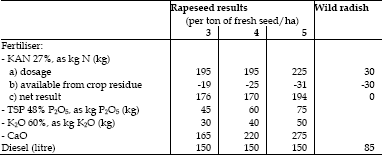<< Previous page Index Next page >>
 English Document English Document
The road to pure plant oil in diesel engines?
Environment-related aspects
Fertilisers and energy carriers
Table 3.3 shows the fertilisers used for the various crop types and the diesel used for
agricultural vehicles. As far as can be seen from the various sources consulted, animal
manure s are generally not used for rapeseed crops. As a comparison, the figures for wild
radish are also given. For both crops, the amount of nitrogen has a clear effect on harvests
where the pre-crop was grain. This means that the amount of mineral nitrogen in the soil is
limited, whereby relatively little nitrogen needs to be added. For phosphor, potassium and
calcium it is assumed that balanced fertilisation is used: an amount is added that is equal to
the amount removed by the rapeseed crop. Since wild radish is assumed to be ploughed
back into the field, there is no need to add phosphor, potassium or calcium for this crop. For
further details and explanation, see Appendix D.

Crop protection substances
The seed obtained from rapeseed is generally contaminated with parasitic mould, so
decontamination is necessary. The plant itself can be be attacked by insects such as beetles
and fleas. Rapeseed is also sensitive to tuber rot [Bernelot Moens, 2003]. [Moens, 2003]
recommends using a total of around 7 litres of pesticide per hectare, to fight against plague,
sickness and weeds.
Fertiliser-related emissions
Table 3.5 shows the amount of emissions from evaporation of NH3, rinsing of NO3 and
formation of N2O during nitrification/denitrification. Emissions from N2O are discounted
because the amount of nitrogen available from crop residues during harvesting of mature
crops means that less fertiliser needs to be used. N2O emissions also include emissions from
crop residues and indirect emissions relating to the NO3 that is rinsed out and the NH3 that
is emitted into the air.
NO3 emissions also include the rinsing of nitrogen from decayed crop residues and
emissions. Appendix D shows how these emissions are estimated.
Emissions relating to agricultural vehicles
The emission factors from [MV5, 2000] were used when estimating the emissions into the air
from agricultural vehicles during harvesting. Table 3.5 shows these emissions per year, per
hectare of rapeseed, with respect to agricultural vehicles. The environmental impact
concerning the precombustion7 phase of the diesel is not yet factored into the emission
factors used.
Costs
With respect to costs, the market price of rapeseed is particularly important to the PPO
chain. Various publications, e.g. [Janssens, 2004], [Bernelot Moens, 2003] and [Van der
Mheen, 2003] mention an amount of € 230 ± € 30 per ton (at the field).
When calculating the environmental impact, the market price for straw is generally also
relevant. According to [Janssens, 2004], the results for straw are around 2.5 ton/ha. This
same source mentions that rapeseed straw is, in practice, primarily chopped up, because
there is little demand for this product, as compared to grain straw. Rapeseed straw is only
sporadically used for horses and rabbits, but is also sold for use in cattle stables. There is also
some interest from the pig-farming industry. The study by [Janssens et al., 2004] calculates
results from straw at € 0.035 per kg (if sold by the farmer). Due to the limited sales to date,
the research team has not included the environmental impact of straw. However, if this were
to be included, the effects on the size of the oil to be included in the environmental impact
would be marginal, due to the high market value of rapeseed oil.
<< Previous page Index Next page >>
|